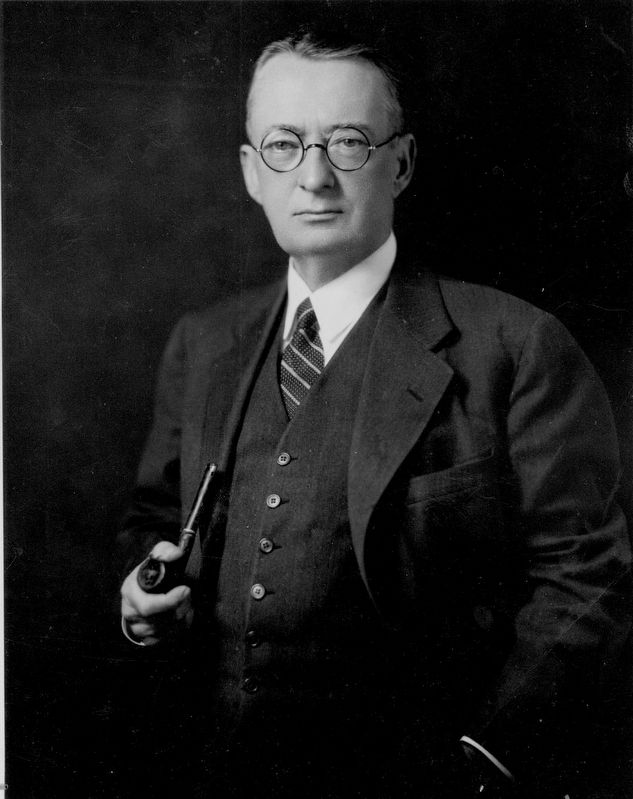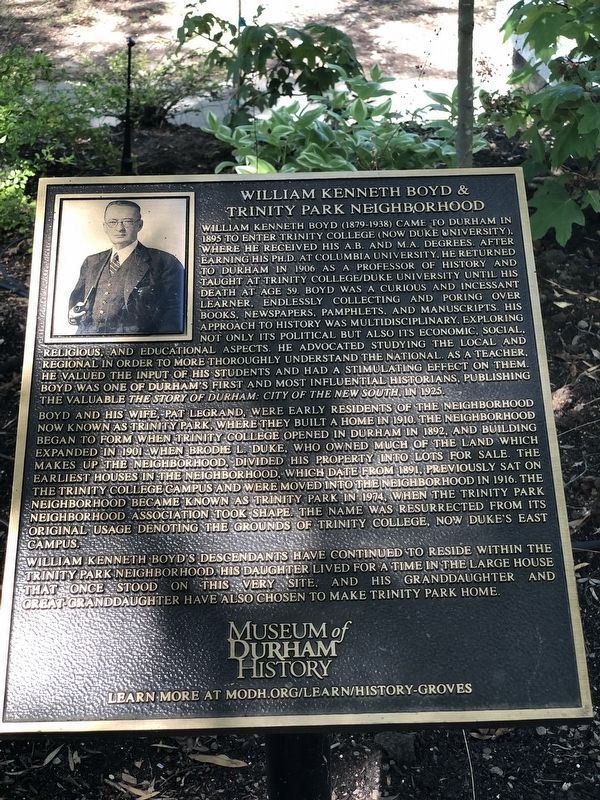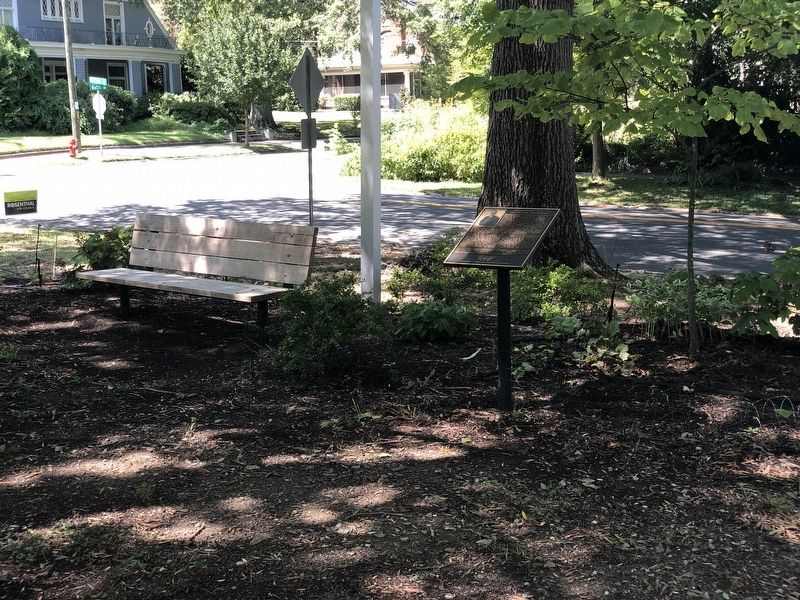Trinity Park in Durham in Durham County, North Carolina — The American South (South Atlantic)
William Kenneth Boyd & Trinity Park Neighborhood
Inscription.
William Kenneth Boyd (1879-1938) came to Durham in
1895 to enter Trinity College (now Duke University),
where he received his A.B. and M.A. degrees. After
earning his Ph.D. at Columbia University, he returned
to Durham in 1906 as a professor of history and
taught at Trinity College/Duke University until his
death at age 59. Boyd was a curious and incessant
learner, endlessly collecting and poring over
books. newspapers, pamphlets. and manuscripts. His
approach to history was multidisciplinary, exploring
not only its political but also its economic, social,
religious, and educational aspects. He advocated studying the local and
regional in order to more thoroughly understand the national. As a teacher,
he valued the input of his students and had a stimulating effect on them.
Boyd was one of Durham's first and most influential historians, publishing
the valuable The Story of Durham: City of the New South, in 1925.
Boyd and his wife, Pat LeGrand, were early residents of the neighborhood now known as Trinity Park, where they built a home in 1910. The neighborhood began to form when Trinity College opened in Durham in 1892, and building expanded in 1901 when Brodie L. Duke, who owned much of the land which makes up the neighborhood, divided his property into lots for sale. The earliest houses in the neighborhood, which date from 1891, previously sat on the Trinity College campus and were moved into the neighborhood in 1916. The neighborhood became known as Trinity Park in 1974, when the Trinity Park Neighborhood Association took shape. The name was resurrected from its original usage denoting the grounds of Trinity College, now Duke's East Campus.
William Kenneth Boyd's descendants have continued to reside within the Trinity Park neighborhood. His daughter lived for a time in the large house that once stood on this very site, and his granddaughter and great granddaughter have also chosen to make Trinity Park home.
Erected by Museum of Durham History.
Topics. This historical marker is listed in these topic lists: Education • Notable Places. A significant historical year for this entry is 1895.
Location. 36° 0.318′ N, 78° 54.652′ W. Marker is in Durham, North Carolina, in Durham County. It is in Trinity Park. Marker can be reached from the intersection of Watts Street and West Trinity Avenue, on the right when traveling north. Marker is by the gazebo in Trinity Park. Touch for map. Marker is at or near this postal address: 410 Watts St, Durham NC 27701, United States of America. Touch for directions.
Other nearby markers. At least 8 other markers are within walking distance of this marker. Warren-Redmond House (within shouting distance of this marker); Joseph Breedlove House (within shouting distance of this marker); Crowell House
(within shouting distance of this marker); Brooks-McCutcheon House (about 400 feet away, measured in a direct line); W.W. Card House (about 400 feet away); LeGrand-Bozarth House (about 500 feet away); Leah Boddie House (about 600 feet away); The King's Daughters Home (about 700 feet away). Touch for a list and map of all markers in Durham.
Also see . . .
1. Boyd, William Kenneth. Boyd went to Trinity just as his mentor, [ John Spencer] Bassett, was leaving after a famous controversy known as the "Bassett Affair." Like Bassett, Boyd was a trenchant critic of an antiquated society intent on using history to support a patriotic bias, but his methods were not controversial. (Robert H. Woody, Dictionary of North Carolina Biography via NCPedia, 1979) (Submitted on September 12, 2023, by Duane and Tracy Marsteller of Murfreesboro, Tennessee.)
2. 410 Watts Street/Trinity Park. History of the neighborhood park and the house that previously stood on it. (Open Durham Project, Preservation Durham) (Submitted on September 12, 2023, by Duane and Tracy Marsteller of Murfreesboro, Tennessee.)

Duke University Archives via Flickr (CC BY-NC-SA 2.0)
3. William Kenneth Boyd (1879-1938)
He had a strong interest in, and published extensively on, regional and southern history. He also actively collected materials for Duke's library, encouraging his students to look for materials in their own homes and hometowns that could be added to the university's collection.
Credits. This page was last revised on September 12, 2023. It was originally submitted on September 12, 2023, by Duane and Tracy Marsteller of Murfreesboro, Tennessee. This page has been viewed 88 times since then and 13 times this year. Photos: 1, 2, 3. submitted on September 12, 2023, by Duane and Tracy Marsteller of Murfreesboro, Tennessee.

